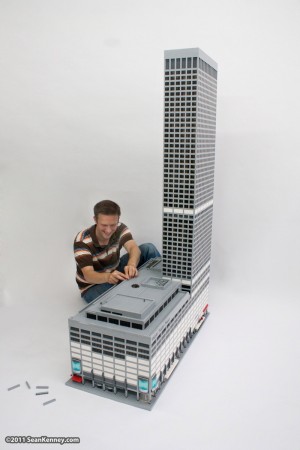A Million (And A Half) Little Pieces: New York Artist Sean Kenney Creates Unbelievable Sculptures with Tiny Bricks
GALO: On average, how long does it take you to design a sculpture with, say, 50,000 bricks?
SK: I created a sculpture of JP Morgan Chase’s logo that contained over 60,000 Lego bricks, [and] it took about eight weeks of full-time work. In contrast, my Greenwich Village model used over 50,000 pieces and took six months of on-and-off work. So, the time it takes to build large pieces varies depending on the level of detail and what kinds of shapes need to be made. Since I work with rectangular bricks, creating curves are more challenging than angular forms.
GALO: Where do you build your sculptures?
SK: I work from my private studio in New York City, in a building that hosts a variety of more traditional artists, such as sculptors, painters, and photographers.
GALO: You’re one of only 13 Lego Certified Professionals in the world. How did you become certified?
SK: I’ve been playing with Lego toys ever since I was a little kid. Even as I entered my teen years and my adulthood, I never stopped building! Eventually, people started commissioning Lego sculptures from me, or asking me to attend events. At the same time, I started having a good relationship with The Lego Group, participating at events or working on projects together. I even started up a Lego fan community.
Somewhere along the line, we realized that if The Lego Group could somehow officially recognize and support people like me, I could reach even more people and spread the word about Lego-coolness even further. From that idea, the idea of Lego Certified Professionals was born, and I became the first of a handful of members. It’s now a few years along (since 2005) and there are 13 of us around the world; we all know each other very well, keep on top of each other’s work, do projects together, and learn from each other by sharing our experiences. And as for who’s next…The Lego Group is in charge of who becomes a Lego Certified Professional, and they’re always keeping their eyes peeled for who might be a good fit.
GALO: When you were a kid, did you ever think you’d get to build with Lego for a living?
SK: I’ve always been obsessed with Lego toys and I’ve always loved to create. Before sculpting with Lego professionally, I was a cartoonist, graphic artist, and web developer. So, although I didn’t imagine I would be a Lego artist for a living, perhaps it was inevitable.
GALO: What was the first Lego set you remember owning? Do you still have it?
SK: I’ve been playing with Lego bricks since before I could remember, but I still own the pieces from my earliest Lego sets. Sometimes, I reuse bricks from older work. It’s nice to know that, after all these years, they still fit together.
GALO: Your Web site says you had a “desk job” before transitioning to creating art with Lego. What kind of a job was it?
SK: Before I became a Lego professional, I worked as a cartoonist, a graphic artist, and a Web site designer. I spent 10 years designing Web site interfaces and Web user experiences, and I wore a suit every day to work.
But the whole time, my “inner child” was itching to get out and play! Every night after work, I would go home and play with my Lego toys…sometimes while I was still in my suit!
GALO: Your bio states you have over 1.5 million Lego bricks. How do you acquire new ones?
SK: I have a special arrangement with The Lego Group that allows me to purchase pieces in bulk directly from the company. But this is a privilege that they have granted to me as part of my relationship as a Lego Certified Professional, and is not something they allow anyone else to do.
GALO: Lego often releases new elements, such as bricks in new colors, etc. Do you incorporate these into your sculptures?
SK: I do, on occasion, use new and limited edition bricks like tan, brown, gray, or orange, especially when creating a realistic model or a portrait. But, I think, there is a particular elegance in using the basic Lego colors (red, blue, yellow, black, and white). The basic bricks really identify something as “Lego” to everyone who looks at my sculptures. A few years ago I created a self-portrait using only red, yellow, and blue Lego pieces. It’s highly stylized and very pop-art-looking; it’s bold and vibrant and fun.
GALO: Has the large amount of media coverage you’ve received added pressure?
SK: I’m always happy to have more media coverage, as it allows me to share my work with the world.
GALO: What do you see in your future?
SK: Currently, I am producing an ever-expanding Lego exhibition tour. In addition, Amazing ABCs and Cool Castles, my fourth and fifth children’s books, are due later this year. The best part about Lego is that you can make anything out of them, so there are [always] an infinite number of new and exciting things to create.

